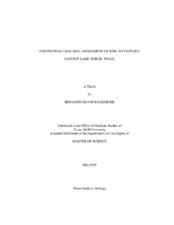| dc.description.abstract | Presented here are the results of a study of geological hazards conducted in Canyon
Lake Gorge of Central Texas. Canyon Lake Gorge formed in 2002 when the emergency
spillway of Canyon Lake was overtopped. Since that time, the gorge has been opened to
public tours, and the organization governing the gorge has expressed concern regarding
visitor safety. The surveys in this study gathered data through field observations and
supplemented those data with non-destructive tests from an impact test hammer. The
goal of this study was to gather original field data on potential hazards of the gorge with
the hope that insight from these data could be used to enhance visitor safety in the gorge.
The field observations made in this study identified the presence of undercut rock
ledges that could present varying degrees of risk to visitors. Easily eroded clayey
wackestone facilitated formation of these potential hazards. Lithologies such as
packstone and grainstone serve to form ledges atop the wackestone. Preexisting
fractures and joints in the ledge forming rock, which compound the danger of the
unstable masses of undercut ledges, provide failure planes. This study identified current
areas of unstable masses by location and differentiates the degree of risk present at each location, using simplified classes of low, medium, and high risk. Level of risk was
determined primarily by the potential injuries incurred. Often, the height was dependent
upon the thickness of an easily eroded wackestone bed that undercuts ledge forming
rock.
Canyon Lake Gorge is a young and dynamic geomorphological environment seeking
equilibrium through gravity facilitated erosional events. In time, natural formation of
riser beds will mitigate the potential hazards of some undercut ledges.
Based on the potential hazards identified in Canyon Lake Gorge, four safety
recommendations are proposed:
- Visitors should always be guided by trained personnel. This practice is in place.
- Visitors should be educated on the dangers of Canyon Lake Gorge before entering.
- Unavoidable hazards should be evaluated for ways to mitigate risk.
- The gorge should be continually monitored to insure safety of the visiting public. | en |


